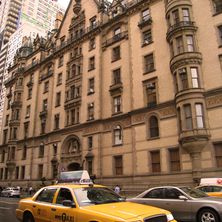

Built between 1880 and 1884, the Dakota was one of the first major residential buildings to be erected on the Upper West Side. Its name is derived from the Dakota Territory, the northwestern US territory that at that time was still very much uninhabited and unsettled, just like Manhattan's Upper West Side. The building stands on the northern corner of 72nd Street and Central Park West and ever since its creation has been one of the most prestigious apartment complexes in the city, with prices ranging from four to thirty million dollars per apartment. In fact, after its construction, renting an apartment there was a must for every member of high society.
The eight-floor building was designed by architect Henry Janeway Hardenbergh for Edward Clark, President of the Singer Sewing Machine Company. Unfortunately Clark died before the completion of the building and construction continued by his heirs. The style and layout is a mixture of North German Renaissance and 19th century French architecture from the Haussmann period. The square structure contains deep roofs, high gables, niches and balustrades, which definitely contribute to its European Gothic feel. It is not a high building, compared to its neighbors, but it has a strong presence on Central Park West, which is due precisely to its foreign style and highly elaborate details.
A courtyard lies in the center of the building, which can be accessed from the main gate on 72nd Street. Originally, the complex had sixty-five apartments with anywhere from four to twenty rooms. The apartments were arranged in the French enfilade fashion, whereby all the major rooms were connected to a separate hallway, as well as to each other through a succession of doorways.
The list of famous Dakota residents, former and current, is endless. To name just a few, we can mention actresses Lauren Bacall, Judy Garland, actors Jack Palace and Jason Robards, conductor Leonard Bernstein, singer Roberta Flack and ballet dancer Rudolf Nureyev. But the most famous Dakota resident, the one with whom the apartment building is always associated in the minds of New Yorkers and tourists alike, is of course John Lennon.
John Lennon lived in the Dakota from 1973 to 1980, owning five apartments in the building. Most of the music he composed after the Beatles split up was written overlooking Central Park or in Central Park itself. The official videos that were filmed to his songs "Mind Games" and "Starting Over" capture him strolling in the park, on Central Park West - alone and with his family - and immortalize his relationship with Yoko Ono with intimate scenes shot in the apartment itself. Throughout the 1970s Lennon was an icon for an entire generation of musicians and political activists. His frank, liberal and humanitarian stance on every social issue made him a stronghold for pacifists and spiritualists. For his incessant criticism of the Vietnam War President Nixon even tried to deport him out of the country, albeit unsuccessfully. Lennon's soft, sentimental melodies and idealistic lyrics had an inspiration on the entire world of rock and pop music.
Unfortunately, Lennon's life came to an early end when he was shot on December 8, 1980 as he was returning home from the recording studio. It was a shock for the whole world. For New York City his death was a true tragedy and it haunts the Dakota Building until this day. It all happened right outside the building, as Lennon walked out the limousine and entered the gate. He heard two things: the first was someone asking him, "Mr. Lennon?" the second - a round of gunfire. There were five shots. Four bullets entered Lennon's back: three passed out of his chest and one remained nestled by his heart. He managed to climb up the stairs in the archway and call the concierge. The concierge called the police. The police did not wait for the ambulance and took the forty-year-old Lennon to Roosevelt Hospital themselves. They later said that he was still alive in the car. But upon arrival to the hospital his condition quickly deteriorated and he was pronounced dead in the emergency room. The doctors said there was no way anyone could have ever survived those shots: the bullets had ripped through his vital organs and he had lost 80 percent of his blood by the time he reached the hospital.
Lennon's murderer was the twenty-five-year-old Mark David Chapman, a psychologically unbalanced born again Christian from Texas. He had been planning to kill Lennon after growing disillusioned with his spiritual message. Chapman, originally a Beatles fanatic, thought that Lennon had no right in saying that the Beatles were more popular than Jesus. The singer's hypocrisy infuriated him even more when he listened to the song "Imagine," in which Lennon speaks about imagining "no religion, no country and no possessions." Later Chapman would say that, "He told us to imagine no possessions, and there he was, with millions of dollars and yachts and farms and country estates, laughing at people like me who had believed the lies and bought the records and built a big part of their lives around his music." Chapman was given a twenty-year sentence and has been eligible for parole since 2000. However, the hearings have denied him parole seven times, stating that it is not in the community's interest to release a dangerous person like him. He is currently incarcerated at the Wende Correctional Facility in Alden, New York, not far from the city of Buffalo.